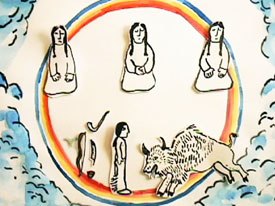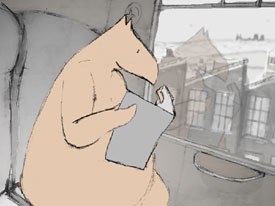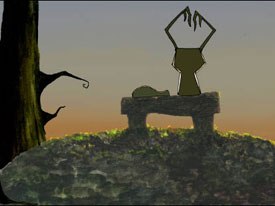Mary Ann Skweres travels to Slamdance and finds the reel winners of the animation competition.
The 2006 Slamdance Film Festival presented eight extraordinary animated films in competition. Using various techniques, ranging from 5-20 minutes in length, the constraints of time and tight budgets that the filmmakers overcame in creating these films is a testament to the artistic dedication of all the independent filmmakers championed by the festival.

Dragon (USA, 7 minutes, color, World Premiere) Director: Troy Morgan For his moody short, Dragon, Troy Morgan received the Grand Jury Prize for Best Animated Short at 2006 Slamdance SparkyAward ceremonies at Suede in Park City.
In the story, a tragic fire leaves a young girl orphaned. Locked in a cramped room of a dingy institution, she escapes her dismal fate through drawing, creating dark imaginary worlds. When the orphanage director discovers her talent, he exploits it for his own profit. The girl is forced to make more of her fantastic creations, until exhausted, she creates one last fiery scenario that comes to life with a vengeance.
Morgan creates his dark fantasy world using hand-sculpted foam rubber puppets and elaborate miniature sets. He shot in the classic stop-motion style of animation 24 frames of movement per second. The use of traditional 2D animation brings the sketched title character to life. Drawn on paper, one frame at a time, then scanned into a computer, the 2D animation was composited in After Effects. The film was edited in Final Cut Pro. Morgan created every element of the production, including the music.
Morgan's youthful obsession with fantasy and horror films formed the super 8 films of his childhood, which utilized the stop motion-techniques of animation pioneer, Ray Harryhausen. He studied film and painting at the San Francisco Art Institute. Post graduation he created music video projects for American McGee and Chris Vienna of Nine Inch Nails. He works in Los Angeles as a freelance animator and vfx artist for clients such as JibJab.

Stasis (USA, 7 minutes, color) Director: Jason Hite Eight years of experience as an industrial designer and sculptor laid the groundwork for Jason Hite to create the futuristic world of Stasis. Beyond the reality of anything we know, this is a world where the graveyards are massive cryostasis chambers where the dead are held until some future time when they can be resurrected into a grotesque nightmare.
The short animation is the beginning of a feature film. The surreal scenario mixes live action with classic stop-motion. Characters were sculpted and miniature sets built. Both the cryo and bio-generator sets were erected in the living room of Hite's one-bedroom, furniture less apartment over the two plus years he worked on the film. The film was shot on a Canon XL1 mini DV camera, composited in After Effects and edited in Adobe Premiere 6. The stop-motion software, Frame Thief, was used to animate the machines and characters.
In 1995, Hite received a full scholarship to the Art Institute of Pittsburgh, beginning his career in special effects. He graduated in late 1997 with a degree in Industrial Design and relocated to Los Angeles. His clients include Fox, Marvel, Disney and Nickelodeon.

The Flooded Playground (USA, 20 minutes, color) Director: Lisa Crafts Lisa Crafts' fascination with the emotional expressiveness of nature is apparent in the richly rendered animated film, The Flooded Playground, which deals with the fears and magical thinking of childhood.
The lines between the real and the imaginary are blurred in this allegorical fairy tale about a young child tormented by a darkly disturbing force until a sudden cataclysm jolts him into a forest wonderland in a quest to heal his damaged spirit.
Crafts uses a hybrid animation style consisting of stop-motion, cutout, drawn and digital effects. Landscapes and other visual elements that had emotional resonance were photographed as ideas for the film were being formulated. The stop motion character sequences were filmed, thousands of photographic elements were digitally manipulated and combined, and the images animated, using the computer as an artist's canvas and animation stand. Photographs for the backgrounds were collected from a scavenger-hunt list of elements required for the film. Although two-dimensional, the work has a three-dimensional complexity and feel.
A self-taught animator and painter, Crafts teaches at the Pratt Institute in New York. She has guest lectured at Harvard and the Rhode Island School of Design and curated animation programs in New York and Japan. Her films have been shown in festivals, museums, theaters, and on television in Europe, Japan and throughout North America. In addition to her own animated films, she has created animated segments for Sesame Street, the Electric Co. and American Movie Classics. Her evocative painted landscapes have been exhibited at galleries in New York and Los Angeles.

The Book of Visions (USA, 12 minutes, color, World Premiere) Director: Annie Poon For her animated short, The Book of Visions, painter and animator, Annie Poon, draws inspiration from the stories of three historical figures Joan of Arc, Sioux Chief Black Elk and Mormon Founder Joseph C. Smith all of whom experienced visions.
Poon's childhood pastime of playing with paper cutout characters influenced her method of animation a paper stop motion technique that presents the perfect medium for telling stories that spring to life out of the pages of a book. Using the character of the elderly professor who receives the mysterious, living book as a narrative device, Poon weaves together the three disparate stories. With a distinct visual style appropriate for each tale, she takes the viewer on a mythical journey into the supernatural along with these legendary leaders from the past. Poon crafted the whole film herself, including the music.
Poon's first collection of short animations, The Paper Theater, was released in 2004. Her work has shown in various venues and film festivals including Nicktoons TV, the Brooklyn International Film Festival, the Chicago International Children's Film Festival and BAM Kidsfest. She studied at the school of Visual Arts in New York, where she now works as an independent animator.

The Love Train (U.K., 8 minutes, color) Director: Eva Bennett The Love Train by Eva Bennett follows the humorous journey of a lovelorn lady dragon searching through a frozen northern landscape for a mate who wont melt from her passion. In an affirmation that anyone can find someone to love, Bennett uses 2D, hand-drawn animation and a limited color palette to tell the story of her hot-blooded protagonist.
Yorkshire native Bennett spent her late teens in jobs such as Chief-T-Shirt-Folder. She spent some time in London surrounded by mice and tramps before heading to the French Alps. She graduated in 2005 with a First Class Honors degree in Animation and a portfolio containing drawings of her naked mother.

The Boy With No Name (U.K., 5 minutes, color, US Premiere) Director: Adam Smith In his animated short, The Boy With No Name, Adam Smith tells the mournful tale of a misfit orphan ensnared in a world where he doesnt belong. Embarking on a journey to find out who he really is, the lost soul eventually discovers the answer, but the knowledge that should set him free is yet another trap. The film is hand-drawn animation done in a whimsical style with a narrator telling the story.
Smith studied at the Wimbledon School of Art, experimenting with stop-motion animation and super 8. He continued his studies in animation for three years at the Southampton Institute where he produced The Boy With No Name, which he completed in the summer of 2005.

Vaudeville (South Korea/U.S., 5 minutes, color) Director: Chansoo Kim Chansoo Kim pays tribute to his grandparents in his interpretive animated film, Vaudeville. In this highly personal history of 1930s Korea, Kim uses a surreal setting and metaphorical incidents to illustrate a time when sentimental pop songs and crude comedy shows masked the adversity and impassable walls Koreans faced while under Japanese occupation. He worked long hours on the 2D animation, which took a year and a half to complete.
Kim was a West Coast Regional Finalist for the 2005 Student Academy Awards. He studied animation at the University of Southern California and has produced short animated films using various techniques. His films have screened internationally. His animated films, Woman in the Attic and Floating, garnered critical acclaim on the festival circuit.
Left and Leave (USA, 10 minutes, color, World Premiere) Director: Yongchu Suh Addressing memories and psychological states, Left and Leave by Yongchu Suh is an animated road movie attempting to reveal the subconscious. The animation is created from a left-handed pencil drawing by a left-handed artist.
Born in Seoul, South Korea, Suh received his BFA in 2001 from New Yorks School of Visual Arts. In 2005, he earned a MFA from the California Institute of the Arts. yongchusuh@hotmail.com
Best of Slamdance screenings will be held on February 9 and 16 in New York at the Two Boots Pioneer Theatre and in Los Angeles at American Cinematheque Egyptian Theatre, Hollywood. Screenings in other cities to be announced.
Mary Ann Skweres is a filmmaker and freelance writer. She has worked extensively in feature film and documentary post-production with credits as a picture editor and visual effects assistant. She is a member of the Motion Picture Editors Guild.







